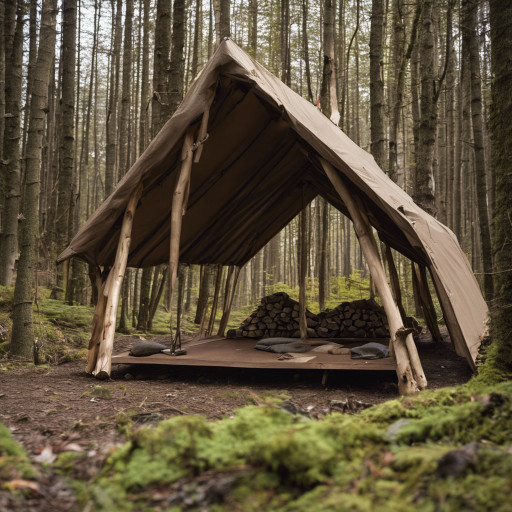Wilderness Shelters 101: Types and Functions
Many people who are looking for an adventure are drawn to the vastness of the wilderness because it offers them a sense of freedom and seclusion. On the other hand, the natural world may be both stunning and cruel. Suppose you find yourself in a position where you need to survive. In that case, it is imperative that you are well-prepared with information and resources, particularly when it comes to constructing shelters in the wilderness. Because they give shelter from the elements and a place to reside in the wide outdoors temporarily, these structures have the potential to be the deciding factor in whether or not there is a chance of survival. This all-encompassing guide will discuss the various kinds of wilderness shelters, their functions, and the most important factors that survivalists should consider.

Building a Lean-To Shelter: A Timeless Wilderness Refuge
When traveling into the great outdoors, ensuring you are safe and comfortable is of the utmost importance. The lean-to building stands out as a traditional and dependable choice for emergency shelters in the woods. This particular kind of shelter is lauded for its ease of construction, effectiveness, and capacity to regularly offer vital protection against the elements.
Constructing the Lean-To Shelter
A lean-to shelter has two main components: a horizontal support and an angled roof. The shelter’s foundation is the horizontal support, usually a fallen tree or a long, solid limb. This component is carefully positioned between two vertical supports, such as trees, to form a solid structure.
After securing the horizontal support, create an angled roof out of smaller branches or leaves. These materials are carefully positioned to create a wind and rainproof barrier. The end result is a shelter that protects you from the elements and features a fire reflector wall. This wall provides structural support while trapping and reflecting heat from a bonfire, resulting in a warmer and more pleasant retreat.
Setting Up Your Lean-To Shelter
First, find a good place with substantial trees or vertical supports to build a lean-to shelter. Lay the horizontal support across these supports to create a strong and level base. Then, strategically arrange smaller branches or leaves at an angle to make the roof and finish the lean-to structure.
As you enjoy the simplicity and effectiveness of your lean-to shelter, you’ll appreciate its timeless design, which provides a sense of security and connection to the outdoors. Whether you’re an experienced outdoor enthusiast or a first-time traveler, the lean-to shelter is a tried-and-true option for building a dependable and durable wilderness hideaway.
Crafting a Debris Hut: Embracing Warmth in Challenging Conditions
When confronted with the problems of colder or wetter conditions in the woods, the debris hut emerges as a clever and cozy shelter solution. This shelter style uses natural detritus, such as leaves or pine needles, to form an insulating cocoon that successfully retains body heat while providing a comfortable haven from the outdoors.
Constructing the Debris Hut
Building a debris hut entails carefully arranging natural materials to create a safe and insulating shelter. Begin by finding an appropriate ridgepole, usually a sturdy and long branch, and securing it horizontally between two trees. This ridgepole provides the shelter’s structural support.
With the ridgepole in place, the following step is to add smaller branches along its length to form a structure that will support the insulation layer. Leave purposeful gaps between these branches to allow airflow and keep the shelter from getting overly stuffy.
The actual brilliance of the trash house is found in its insulation. Cover the framework in a thick layer of natural debris, beginning with larger branches at the bottom and proceeding to smaller materials such as leaves or vegetation at the top. This layering approach provides excellent insulation by trapping air pockets inside the debris, forming a barrier to cold and moisture.
Climbing into Coziness
Once the debris hut is built, the final stage is to crawl into this natural cocoon. Before you settle in, put another layer of insulation beneath you with extra leaves or dirt. This extra layer adds warmth and comfort to the shelter, making it an enticing haven even under the hardest weather.
Using the trash hut as a wilderness sanctuary demonstrates resourcefulness and provides a concrete connection to nature. In harsh climes, this shelter is a monument to human ingenuity, providing a cozy and insulating sanctuary amid the rough grandeur of the outdoors.
Crafting an A-Frame Shelter: Swift and Reliable Wilderness Haven
Regarding surviving in the wild outdoors, the A-frame shelter stands out as a quick and dependable solution for individuals looking for a simple refuge. This shelter, designed to resemble the letter A, has two supporting pieces of wood or branches forming the angled sides, making it a lightweight and portable option for emergencies.
Constructing the A-Frame Shelter
Building an A-frame shelter needs little work and materials, making it a viable option for survivalists. First, to create this structure, identify two long branches that will serve as the major supports. Secure these branches to the ground at an angle to form the A-frame’s inverted V shape. This design’s simplicity enables quick setup, which is critical in situations where time is important.
Once the primary supports are in place, the following step is to tie smaller branches or leaves horizontally across them to form a roof. This roofing structure provides basic weather protection, making the A-frame shelter a practical and efficient solution for temporary lodging in the wilderness.
Enhancing Comfort and Insulation
Consider adding insulation between the framework and the roof to increase comfort. This can be accomplished by including natural materials like leaves, pine needles, or grass to form an additional barrier from the cold or damp ground. While the A-frame shelter is simple in construction, these careful improvements can greatly improve its functionality and comfort.
Embracing the simplicity of the A-frame shelter not only offers a dependable wilderness retreat and demonstrates the brilliance of employing basic materials to build a protective area. Whether you’re an experienced outdoors person or in an emergency, the A-frame shelter provides a simple and practical option for shelter and survival.
Crafting a Tarp Shelter: Embracing Versatility and Mobility
The tarp shelter takes center stage regarding shelter solutions that reflect versatility and mobility. A simple tarp, easily folded and stored in a bag, emerges as the preferred option for survivalists who value adaptability in the ever-changing wilderness. With a few simple knots and anchors, a tarp can be changed into various shelter forms, such as an A-frame, lean-to, or hammock shelter.
Versatility Unleashed
The tarp shelter’s main strength is its unprecedented adaptability. Its lightweight and small design makes it a go-to for outdoor enthusiasts looking for a shelter solution that doesn’t limit movement. Whether you’re traveling through dense forests, rocky terrains, or vast plains, a tarp may be easily unfurled and tailored to the needs of the surroundings.
With a little imagination and resourcefulness, a tarp may serve as a dependable shield against the elements in various situations. Need a quick A-frame for an unexpected downpour? Unfold the tarp, tie it with a few stakes, and you’ll have immediate protection. Are you planning on spending the night under the stars? Transform the tarp into a hammock shelter for a suspended and comfortable sleeping situation.
Weather-Ready Adaptability
One of the tarp shelter’s most distinguishing traits is its capacity to quickly adjust to changing weather conditions. Survivalists can readily customize the design to maximize protection from rain, wind, and even direct sunlight. The smart use of knots and stakes enables simple changes, keeping you dry and comfortable regardless of the weather.
Selecting the Right Tarp
To maximize the efficacy of a tarp shelter, use one constructed of a robust and waterproof material. This assures resistance to lengthy exposure to the elements, making it a dependable companion for protracted trips in the wilderness.
The tarp shelter is the ultimate wilderness shelter, providing the ideal balance of versatility, mobility, and adaptation. Its simple appearance belies its ability to save lives in the unpredictable outdoors, making it an essential component of every survivalist’s toolset.
Creating a Snow Cave: Mastering Winter Survival in Nature’s Embrace
In the brutal embrace of difficult winter conditions, survivalists turn to the snow cave as an inventive and life-saving shelter. This shelter uses the insulating properties of snow to transform the frozen environment into a cozy refuge, providing warmth and protection from the biting cold. However, building a snow cave necessitates specialized procedures to provide stability, insulation, and enough ventilation.
Crafting the Winter Wonderland Refuge
Building a snow cave entails more than simply excavating into a mound of snow. It demands precision and an understanding of snow’s unique qualities. The method begins with locating an appropriate pile of thickly packed snow. Once discovered, survivalists carefully excavate the snow to build an interior area that not only accommodates the person but also takes advantage of the insulating properties of snow.
To improve insulation and keep cold air out, ensure that the snow cave’s entrance is lower than the sleeping space. This strategic placement creates a natural barrier against the incursion of cold air, resulting in a warmer and more comfortable interior.
Elevated Sleeping Area and Ventilation Mastery
The sleeping chamber of the snow cave is elevated above the ground, further insulating people from the freezing surface. Carving a ventilation hole near the ceiling is critical in allowing fresh air circulation. Proper ventilation reduces the development of stale air and aids in the management of condensation concerns that may arise throughout the night.
Survivors must strike a precise balance between insulation and ventilation when building a snow cave. Too little insulation allows the cold to permeate; too little ventilation causes the air to get stagnant, increasing the risk of condensation. This delicate dance with nature’s forces transforms the development of a snow cave into an art and a science, requiring talent and experience.
Navigating the winter wilderness becomes a transforming experience if you’ve learned how to build a snow cave. In the midst of nature’s icy grasp, this shelter demonstrates human adaptability and inventiveness, transforming a harsh environment into a winter wonderland haven.
Key Considerations for Wilderness Shelters
1. Location: Choosing a Strategic Wilderness Site
Strategic preparation is essential when deciding on a place for your wilderness shelter. Consider the closeness of water sources for hydration as well as potential dangers such as dead trees or rockfalls that may represent a safety issue. Natural windbreaks created by larger trees or rock formations can protect your shelter from strong gusts. Avoid low-lying locations prone to floods, and ensure your chosen site combines proximity to resources with safety.
2. Materials: Harnessing Nature’s Bounty
Use the materials available in your environment to build an excellent shelter. Fallen branches, leaves, greenery, or snow can be used effectively. Prioritise dry materials to avoid moisture-related problems that could jeopardize the structural integrity of your shelter. Resourceful utilization of the environment improves the shelter’s functionality and demonstrates survival skills in maximizing available resources.
3. Size and Accessibility: Balancing Coziness and Convenience
Maintain a balance between the size of your shelter and the requirement for warmth retention. Keeping it small and compact reduces heat loss while providing enough space to crawl inside comfortably. Easy access is critical, particularly in emergency situations where quick entry and evacuation may be required. Finding the correct balance between coziness and convenience is critical for an efficient wilderness shelter.
4. Ventilation: Breathing Easy in the Outdoors
Adequate ventilation prevents condensation and maintains a fresh breeze in your shelter. Whether you’re building a debris hut or a snow cave, include ventilation holes or breaks in your design. This procedure is especially important in enclosed structures since it improves comfort while lowering the danger of problems caused by stagnant air. A well-ventilated shelter considerably improves overall livability.
5. Insulation: Battling the Chill with Effective Insulation
Improve your shelter’s insulation to keep you warm on cold nights. Increase insulation by placing layers of garbage, leaves, or dry grass between yourself and the ground. In addition, layer insulating materials in the shelter walls to form a barrier against external cold. This deliberate technique preserves body heat, resulting in a warmer and more pleasant retreat.
6. Fire Safety: Harnessing Heat Safely
While a fire within your shelter provides warmth and utility, it also poses concerns. Ensure appropriate ventilation to prevent smoke accumulation, and build a fire reflector. This safety feature sends warmth into your shelter while reducing the possibility of accidental flames spreading to the building, promoting a balance of comfort and safety.
7. Emergency Signaling: Making Your Presence Known
In survival situations, enhancing visibility to possible rescuers is critical. Use natural materials or bright things to make conspicuous signs like arrows or distress signals on open land or snow. This proactive strategy increases your chances of being seen in an emergency, making it a useful tool for communication and rescue efforts.
Wilderness shelters are essential for surviving and thriving in the wild. Survivalists can efficiently adapt to varied surroundings and defend themselves from the elements if they understand the many types of shelters and their purposes. Always prioritize safety, practice shelter-building techniques before traveling into the woods, and arm yourself with critical survival knowledge. With the right skills and preparations, wilderness shelters can help you overcome nature’s hardships and ensure your survival. Stay informed, stay connected, and continue exploring the untamed outdoors!
The post Wilderness Shelters 101: Understanding Different Types appeared first on Survivalbite.
The Article Wilderness Shelters 101: Understanding Different Types was found on https://limitsofstrategy.com
The Article Wilderness Shelters 101: Understanding Different Types First Appeared ON
: https://ad4sc.com









Comments are closed